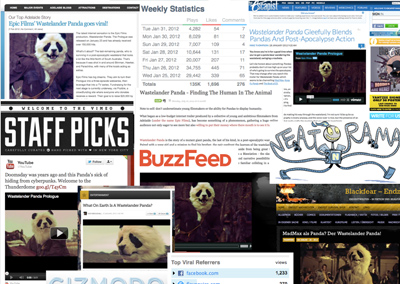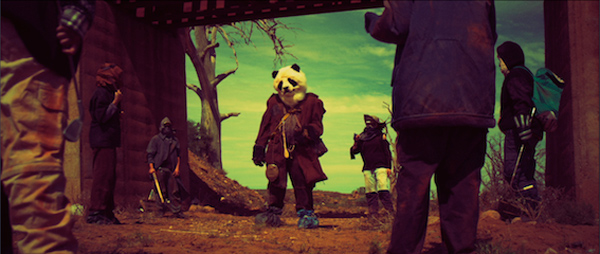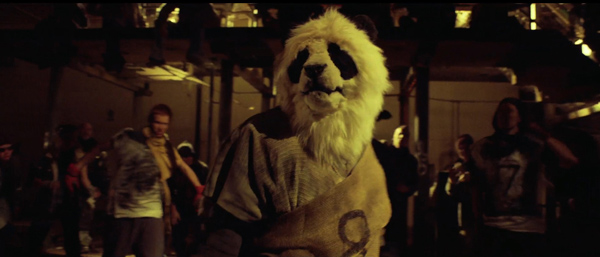by Kirsty Stark (Producer), Ella Macintyre (PMD) and Victoria Cocks (Writer/Director)
Part 2. Promotion: How We Drove our Prologue to 100,000 views in 3 Days
The day we posted our three-minute Wastelander Panda Prologue online, our intention was to share it with friends, with the hope that others would also enjoy it. The accessibility and overwhelming amount of content on the Internet gives you a sense that you can easily put something up and people will find it. What we realized is that realistically, you have to put it in front of them. The evening we uploaded it, we happened to be at our friend Ella Macintyre’s house. She’s one of those people that has grown up on the Internet, and knows it backwards and forwards – which blogs are owned by which media companies, who pays attention to whose content, and how information spreads from one place to the next. The first thing she asked us was “So, where are you sending this thing?”

Despite our initial ignorance, and lack of prior planning, we managed to have our Prologue seen by over 100,000 people in its first three days online. Part of that success came down to our content. The concept was unusual; the film had higher production values than many Internet videos, and the idea appealed to many existing niche groups online. However, without getting the Prologue in front of those groups, Wastelander Panda would have gone no further.
1. Our first step was to help us identify the different niche groups that the Prologue would appeal to, and then contact them. We were lucky that we were already part of the audience we were trying to target, and we had an existing awareness of where the content would fit best, and how it was likely to be spread to other blogs through affiliate networks and social media. This is something that we would otherwise have had to spend time researching.

2. We then spent time contacting the high priority websites on our list, through a combination of emails to editors, content suggestions through submission forms, and anonymous ‘tips’ that appeared to come from fans, rather than us. For straight news sites, we also submitted official press releases.
3. We were sure to target our messages directly to the audiences of those particular blogs. Filmmaking sites received information about the process we went through, while sci-fi and geek blog submissions were more about the content. We tried to write each submission so that the content was targeted directly to the website’s audience, and all their editor had to do (if short on time), was copy and paste our information, add a comment or two, and embed a link to the Prologue.
4. Once we began to be mentioned on a few different blogs, we tracked the attention we were getting using Vimeo’s in-built statistics and Google Alerts, and began to concentrate our efforts on the areas that were working best. Vimeo allowed us to track audience demographics, including the countries and cities they were watching from, and focus on further promotion to those areas. We could also see the individual websites that had embedded the Prologue, and track the numbers of people seeing the video thumbnail, and the percentage that were then taking the time to watch. Paying attention to the site demographics and types of content, we then focused our attention on similar websites, and sent them emails as well.

5. On one particular site, where a lot of the front page content is dictated by user votes, we noticed that a higher-than-average number of people were watching the video, so we asked our friends and new fans to vote, and increase the attention we were getting there. This brought our video to the attention of the site’s editors, and we were featured on the front page the next day.
However, it is very important to recognize that members of online communities or forums will notice an imposter straight away. Being members of our own target audience really helped in this regard, as we were already part of a lot of these online communities, or knew people who were. Otherwise, we would have been wary of trying to promote our work to them without spending time contributing to the community and getting to know their audience and the types of content that were well-received.
6. For something like the Prologue, which is attention-grabbing and short (3 mins), we knew that its best chance of spreading would be to create as much buzz around it in its first few days online. For short, viral content, its value decreases the older it gets, because websites and viewers don’t want to look like they are behind the times by posting something that their readers and friends may have already seen. For this reason, we tried to spread it as far and wide as we could, as quickly as possible.

7. The added bonus of this method was the additional publicity that came from the intense interest in the Prologue. For a few days, it seemed like it was “everywhere,” and being able to write a press release using the angle of having so many views so early enabled us to generate articles in the more mainstream news. This helped us to prove the legitimacy of the project in the offline world. The high number of views in a short period of time also caught the attention of the Vimeo Staff, who made our video a Staff Pick on its second day online, again taking it to a wider audience.
8. After the initial buzz around the Prologue died down, we took note of the lessons we learned from the release, in order to apply them to future online promotion. However, with almost 40 minutes of combined content between our three new films, we expected from the start that any buzz surrounding the release would be much smaller. It’s much more difficult to get people to commit to watching long-form content online as part of their regular browsing activity, so we specifically designed on episode, Arcayus & Akira, to be much shorter, giving it greater appeal to casual browsers. We have also focused on generating new strategies to increase word of mouth and long-term viewing for the new episodes.
Wastelander Panda is a live-action sci-fi project, written and directed by Victoria Cocks, that tells the tale of the last remaining panda in a post-apocalyptic Wasteland. The first three Wastelander Panda films are available at http://www.wastelanderpanda.com, in conjunction with an interactive map allowing users to explore the Wasteland. The team has now signed a co-production deal with Madman in Australia, and is developing further episodes with the Australian Broadcasting Commission and the South Australian Film Corporation. This series of posts by Producer Kirsty Stark (@kirstysan), PMD Ella Macintyre (@Ella_Macintyre) and Writer/Director Victoria Cocks (@VictoriaCocks1) outlines the process the team went through as first-time filmmakers to bring Wastelander Panda to its current funded stage.





